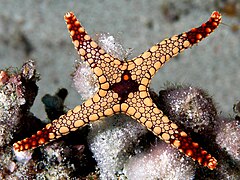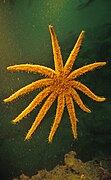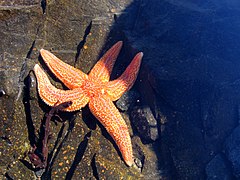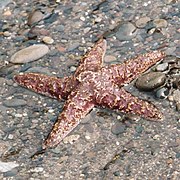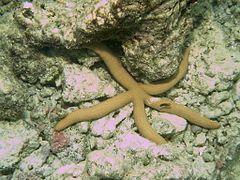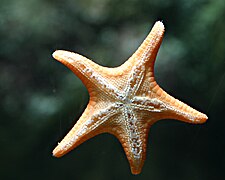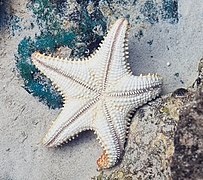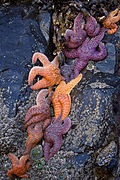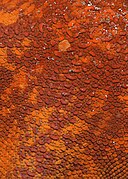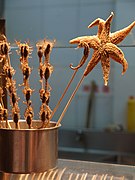Asteroidea
- Pro subfamilia plantarum florentium, vide "Asteroideae".

Forcipulatida
Notomyotida
Paxillosida
Spinulosida
Valvatida
Velatida
Calliasterellidae †
Asteroidea, vulgo aliquando stellae marinae,[1][2][3] sunt animalia marina subphyli Asterozoorum phyli Echindermatorum.[4]
Descriptio
[recensere | fontem recensere]Asteroidea aspectu stellae similia sunt, itaque his duobus nominibus appellantur. Sunt circa 1800 species vivae, quae in omnibus orbis terrarum oceanis inveniuntur, inter quos oceani Atlanticus, Pacificus, Indicus, et regiones oceanorum Arctici et Australis (h.e., ante Antarcticam). Asteroidea fiunt trans latam profunditatis varietatem, a zona inter aestus ad zonam abyssalem? (plus 6000 m).
Asteroidea sunt inter familiarissima animalium marinorum, quibus sunt aliquae proprietates late notae, inter quas regeneratio atque Mytilidae comesae. Eis sunt permultae corporis formae et rationes edendi. Gradus quo Asteroidea se regenerare possunt specie variatur. Sensu lato, asteroidea commoditatis gratia vescuntur, et nonnullis speciebus sunt peculiares vescendi mores, inter quos pascendum suspendendi? (Anglice suspension feeding) et praedatio praedae propriae.
Asteroidea nonnullas personas graves in oecologia et biologia agunt. Pisaster ochraceus et species similes ut exemplum notionis species clavis in oecologia late cognitae sunt. Acanthaster planci tropicus est edax curalii praedator per regionem Indo-Pacificam. Alia asteroidea, sicut genera Asterinidarum, saepe in biologia evolutionis adhibentur.
Classificatio
[recensere | fontem recensere]- Infraclassis Concentricycloidea
- ordo Peripodida
- familia Xyloplacidae Baker, Rowe & Clark, 1986
- ordo Peripodida
- Superordo Forcipulatacea
- ordo Brisingida
- familia Brisingidae G.O. Sars, 1875
- familia Freyellidae Downey, 1986
- ordo Forcipulatida
- familia Asteriidae Gray, 1840
- familia Heliasteridae Viguier, 1878
- familia Pedicellasteridae Perrier, 1884
- familia Pycnopodiidae Fisher, 1928
- familia Stichasteridae
- familia Zoroasteridae Sladen, 1889
- ordo Brisingida
- Superordo Spinulosacea
- ordo Spinulosida
- familia Echinasteridae Verrill, 1870
- ordo Spinulosida
- Superordo Valvatacea
- ordo Notomyotida
- familia Benthopectinidae Verrill, 1899
- ordo Paxillosida
- familia Astropectinidae Gray, 1840
- familia Ctenodiscidae Sladen, 1889
- familia Goniopectinidae Verrill, 1889
- familia Luidiidae Sladen, 1889
- familia Porcellanasteridae Sladen, 1883
- familia Pseudarchasteridae
- familia Radiasteridae Fisher, 1916
- ordo Valvatida
- familia Acanthasteridae [Sladen, 1889]
- familia Archasteridae Viguier, 1878
- familia Asterinidae Gray, 1840
- familia Asterodiscididae Rowe, 1977
- familia Asteropseidae Hotchkiss & Clark, 1976
- familia Chaetasteridae Sladen, 1889
- familia Ganeriidae Sladen, 1889
- familia Goniasteridae Forbes, 1841
- familia Leilasteridae Jangoux & Aziz, 1988
- familia Mithrodiidae Viguier, 1878
- familia Odontasteridae Verrill, 1899
- familia Ophidiasteridae Verrill, 1870
- familia Oreasteridae Fisher, 1911
- familia Podosphaerasteridae Fujita & Rowe, 2002
- familia Poraniidae Perrier, 1875
- familia Solasteridae Viguier, 1878
- ordo Velatida
- familia Caymanostellidae Belyaev, 1974
- familia Korethrasteridae Danielssen & Koren, 1884
- familia Myxasteridae Perrier, 1885
- familia Pterasteridae Perrier, 1875
- ordo Notomyotida
Pinacotheca
[recensere | fontem recensere]-
Magnum asteroideum rubrum in Komodo National Park Indonesiae
-
Asteroideum in Komodo National Park Indonesiae
-
Pycnopodia helianthoides, maxima stella marina orbe terrarum, hic in piscina inter aestus in California sita visa
-
In piscina inter aestus ubi scorpaeniformis Leptasteridem hexactis comedit
-
Pisaster ochraceus in Bamfield Canadae
-
Linckia guildingi in Meedhupparu house reef in Insulis Maldivis
-
Pedes tubiformes hic videri possunt
-
Oreaster reticulatus, Cancun, Mexico
-
Protoreaster linckii, stella marina ex Oceano Indico
-
Cutis stellae marinae
Nexus interni
Notae
[recensere | fontem recensere]- ↑ Georgius Everhardus Rumphius, D'Amboinsche Rariteitkamer, behelzende eene beschryvinge van allerhande zoo weeke als harde schaalvisschen, te weeten raare krabben, krefften, en diergelyke zeedieren, als mede allerhande hoorntjes en schulpen, die men in d'Amboinsche Zee vindt: daar benevens zommige mineraalen, gesteenten, en soorten van aarde, die in d'Amboinsche en zommige omleggende Eilanden gevonden worden, ed. 2a (Amstelodami: Jan Roman de Jonge, 1741), prima editio, 1705. Vide Plate XV: Stella Marina, Zeesterren (Asteroidea, Starfish, Sea Star species).
- ↑ "Chapter 34. Of the Stella Marina. Bintang Laut. 1. I translated Rumphius' Latin name as 'Sea Stars,' a locution once just as common as 'Starfish' is now. . . . In Malay it means the same thing: bintang = star, and laut = sea." Georgius Everhardus Rumphius, The Ambonese Curiosity Cabinet, liber in Anglicum conversus, editus, adnotatus ab E. M. Beekman (Portu Novi: Yale University Press, 1999), p. 412.
- ↑ "The first reference Weber could find to the starfish was made by Rumphius in 1705, who referred to it as Stella marina quindecium [sic] radiorum"---Jan Sapp, What Is Natural? Coral Reef Crisis (Oxford University Press, 1999), p. 219.
- ↑ Rich Mooi, "Classification of the Extant Echinodermata." California Academy of Sciences.
Bibliographia
[recensere | fontem recensere]- Blake, D. B., et T. E. Guensburg. 2005. Implications of a new early Ordovician asteroid (Echinodermata) for the phylogeny of Asterozoans. Journal of Paleontology 79(2):395-399.
- Gilbertson, Lance. 1999. Zoology Lab Manual. Ed. 4a. Novi Eboraci: McGraw Hill Companies. ISBN 007237716X.
- Shackleton, Juliette D. 2005. Skeletal homologies, phylogeny and classification of the earliest asterozoan echinoderms. Journal of Systematic Palaeontology 3(1):29-114.
- Solomon, E. P., L. R. Berg, et D. W. Martin. 2002. Biology. Ed. 6a.
- Sutton M.D., D. E. G. Briggs, D. J. Siveter, D. J. Gladwell. 2005 A starfish with three-dimensionally preserved soft parts from the Silurian of England. Proceedings of the Royal Society B: Biological Sciences 272(1567):1001-1006.
- Hickman C. P, L. S. Roberts, A. Larson, H. l'Anson, et D. J. Eisenhour. 2006. Integrated Principles of Zoology. Ed. 13a. Novi Eboraci: McGraw Hill. ISBN 0071115935.
Nexus externi
[recensere | fontem recensere]| Vicimedia Communia plura habent quae ad asteroidea spectant. |
| Vide "asteroidea" apud Vicispecies. |
- Classificatio Echinodermatum Exstantium apud situm calacademy.org
- De Asteroideis apud situm users.on.net (Starfish–Sea Stars)
- De detrimento Echinodermatibus a pollutione olei effecto apud ocean.si.edu
- De ordine apud situm tolweb.org (Propositum Arboris Vitae)
- Photographemata Asteroideorum apud situm starfish.ch.c-invertebrates/seesterne.html
|
Haec stipula ad Echinodermatum spectat. Amplifica, si potes! |
Text is available under the CC BY-SA 4.0 license; additional terms may apply.
Images, videos and audio are available under their respective licenses.

